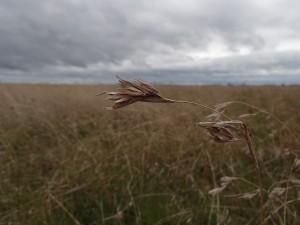
Mortlake Common Flora Reserve – Threatened flora of the Western Volcanic Victorian Plains

Old seed heads of native Kangaroo Grass, which dominates areas of grassland within the Mortlake reserve (photo: L.Kivisalu)
The Mortlake Common Flora Reserve represents one of the largest and most herb-rich grasslands within the Western Volcanic Plains region, approximately 300 hectares in size. The reserve encompasses Plains Grassland/Plains Grassy wetland mosaics, and formerly Grassy Woodland, as indicated by the presence of scattered River Red Gums (Eucalyptus camaldulensis) and Tree Everlasting (Ozothamnus ferrugineus).
A number of Leek-orchid populations occur within the reserve, including the Basalt Leek-orchid, as well as the undescribed Western Gaping Leek-orchid (Prasophyllum sp. aff. correctum), with the latter known only to this site. The management of invasive species such as Gorse, as well as Phalaris (Phalaris aquatica) will be undertaken to promote an open and functioning grassland system, and increase the habitat condition for these rare flora species.
On-ground actions
So far, focus has been on control of of a stand of gorse in the northern section of the site, along with Phalaris in the south-east. Weedy grasses that have been moving into the seasonally inundated wetland in the middle of the reserve have been treated. Upcoming activities include continuing gorse and weedy grass control, mapping of the Basalt Leek-orchid, and taking a good look at the hydrological regime of the site which may be affecting flow of nutrients into the site and encouraging invasive weeds. A community grassland tour is in the works and will promote these extremely endangered ecosystems – which reveal little from a distance, but on a closer look a huge variety of rare and fascinating species and interactions can be found!

